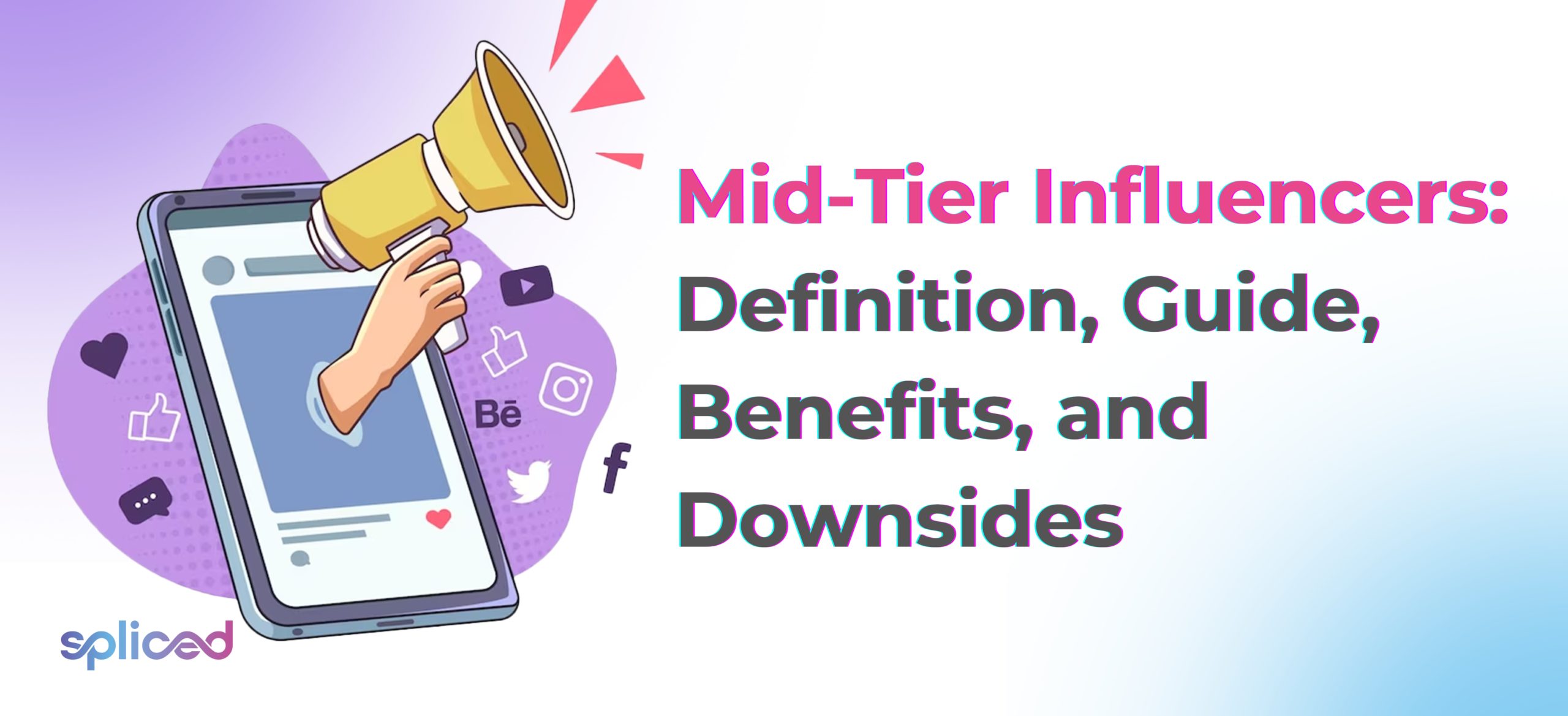Mid-tier influencers have a moderate social media following and frequently range from tens of thousands to several hundred thousand followers. Mid-tier influencers strike a mix between niche expertise and broad appeal that makes them adaptable for brands seeking to engage with certain audiences while retaining more followers.
Begin by outlining the marketing goals and prospect audiences before looking for mid-tier influencers. Search for people in the area of interest using social media channels and influencer marketing tools. Examine their content for originality and engagement rates. Assess the content’s importance to the brand and its alignment with the beliefs. Start dialogues and negotiate arrangements that are beneficial to both sides.
Mid-level influencers give a mix of benefits and drawbacks. More meaningful connections with their audience are the outcome of their moderate follower count’s tendency to produce greater engagement rates than those of larger influencer tiers. They are less expensive and more accessible than macro or mega-influencers, making collaborations more cost-effective. Mid-tier influencers lack the extensive reach of higher-tier influencers, restricting exposure to a broader audience.
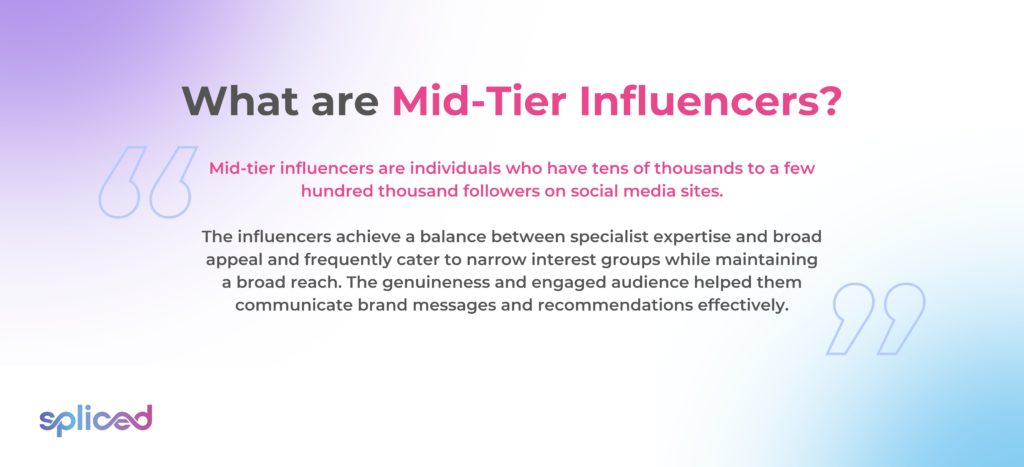
What are Mid-Tier Influencers?
Mid-tier influencers are individuals who have tens of thousands to a few hundred thousand followers on social media sites. The influencers achieve a balance between specialist expertise and broad appeal and frequently cater to narrow interest groups while maintaining a broad reach. The genuineness and engaged audience helped them communicate brand messages and recommendations effectively.
Mid-tier influencers occupy a unique place in the influencer marketing landscape, exhibiting a dynamic strategy that blends the authenticity of smaller influencers with a bigger reach. They have the ability to connect with a focused audience while being relatable with follower counts that exceed those of micro-influencers but are less than macro or mega-influencers. Mid-tier influencers frequently specialize in specific domains or themes, providing in-depth views and knowledge to their audience. The influencers have the ability to influence ideas and actions within their group which makes them vital assets for marketers wishing to engage in focused marketing.
The value of mid-tier influencers resides in their ability to forge genuine connections inside their expertise while providing a reasonable reach to a larger audience. The influencers efficiently bridge the gap between micro and larger influencers, catering to both their core followers’ unique interests and the wider visibility marketers desire. Mid-size influencers allow brands to reach out to engaged groups and deliver their messages through credible advocates who have the experience and relatability that their audience values. Mid-tier influencers’ mix of skill and reach positions them as vital in getting a balance between targeted engagement and broader brand visibility within influencer marketing campaigns.
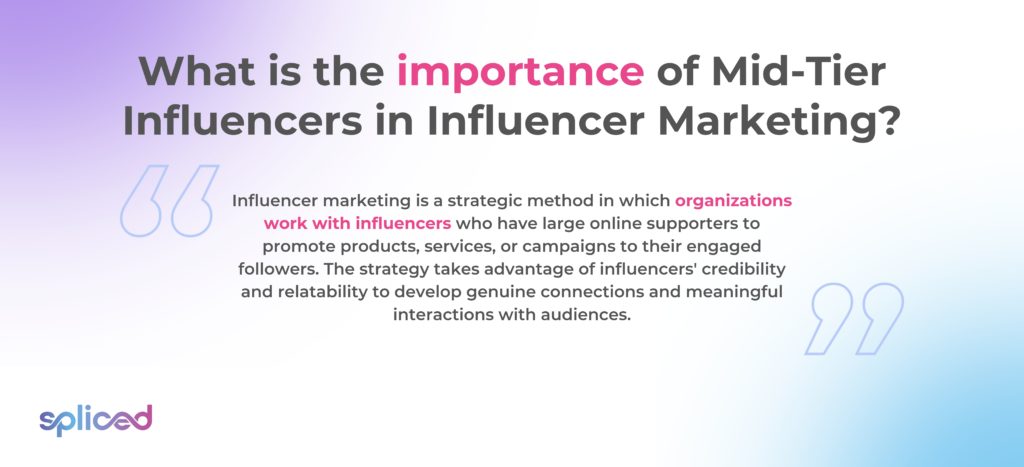
What is the importance of Mid-Tier Influencers in Influencer Marketing?
Influencer marketing is a strategic method in which organizations work with influencers who have large online supporters to promote products, services, or campaigns to their engaged followers. The strategy takes advantage of influencers’ credibility and relatability to develop genuine connections and meaningful interactions with audiences.
Mid-tier influencers play an important part in the world of influencer marketing due to providing unique blend of authenticity, specialty expertise, and moderate reach. Their value stems from their ability to find a balance between micro-influencers and larger influencers, creating highly engaged communities within specialized niches while providing broader exposure that appeals to a larger audience. The combination results in more honest connections with their followers, which leads to increased engagement and trust in their suggestions.
Influencer marketing benefits from the relatability and approachability that mid-tier influencers bring because they frequently communicate directly with their followers and respond to their messages and comments. The personal touch boosts the sense of legitimacy of their endorsements. The smaller follower network allows them to connect on a deeper level, cultivating more intimate relationships with their followers than influencers with large followings.
Partnering with mid-tier influencers is cost-effective while offering great value for a brand. The influencers’ genuineness and trustworthiness resonate with consumers, resulting in greater conversion rates and meaningful brand interactions. Working with mid-tier influencers helps marketers tap into narrow networks, precisely targeting specific demographics while still enjoying a greater reach than micro-influencers. The deliberate approach to influencer marketing results in a combination of targeted engagement and broader brand visibility, making mid-tier influencers an important component of effective influencer marketing programs.
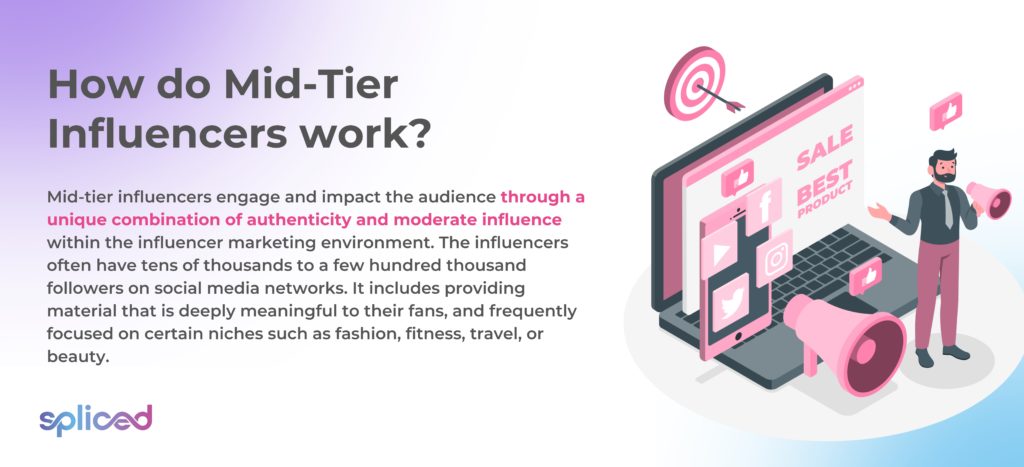
How do Mid-Tier Influencers work?
Mid-tier influencers engage and impact the audience through a unique combination of authenticity and moderate influence within the influencer marketing environment. The influencers often have tens of thousands to a few hundred thousand followers on social media networks. It includes providing material that is deeply meaningful to their fans, and frequently focused on certain niches such as fashion, fitness, travel, or beauty.
Mid-tier influencers position themselves as reliable sources of knowledge in their chosen niche by sharing insights, recommendations, and personal experiences with their audience. They connect with people on a personal level, replying to comments and messages and establishing a sense of community. Participation increases their authenticity and develops true relationships with their followers, resulting in increased levels of engagement and trust.
Brands team up with mid-level influencers to promote their products, services, or campaigns. The collaborations entail incorporating the brand’s offerings into the influencer’s content in a natural and real manner. Mid-tier influencers’ efficacy stems from their ability to connect with their followers’ interests, addressing their wants and preferences while delivering brand messaging in a relatable manner.
Mid-tier influencers promote interaction, encourage dialogues, and motivate their audience to take action by utilizing the trust and authority they have built within their specialty. Mid-tier influencers are positioned as effective intermediaries that bridge the gap between businesses and customers, resulting in meaningful interactions and a better possibility of conversions with the personal and honest approach to influencer marketing.
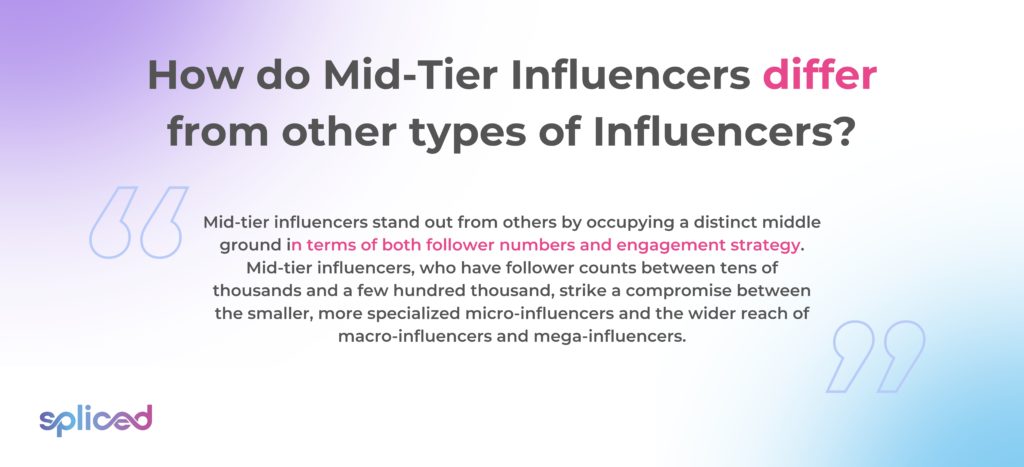
How do Mid-Tier Influencers differ from other types of Influencers?
Mid-tier influencers stand out from others by occupying a distinct middle ground in terms of both follower numbers and engagement strategy. Mid-tier influencers, who have follower counts between tens of thousands and a few hundred thousand, strike a compromise between the smaller, more specialized micro-influencers and the wider reach of macro-influencers and mega-influencers. The middle ground allows mid-tier influencers to interact with a larger but still engaged audience while being real and approachable.
Mid-tier influencers often have a slightly larger following and a broader appeal than micro-influencers, making them more versatile for addressing varied groups. They have a more established internet presence, which is frequently matched with a breadth of knowledge and skill in their chosen area. Mid-tier influencers retain a better relationship with their audience than macro or mega-influencers and enable more personal interactions and higher engagement rates. The degree of engagement is frequently due to their ability to speak on a relatable level while still having a larger reach than micro-influencers.
One of the types of influencers is Mid-tier influencers, which provide a smart balance between micro-influencers’ specific knowledge and larger supporters. The ability to communicate authentically with the followers while providing a reasonable amount of exposure causes them an important component of influencer marketing campaigns that seek engagement inside specific communities and larger brand visibility.
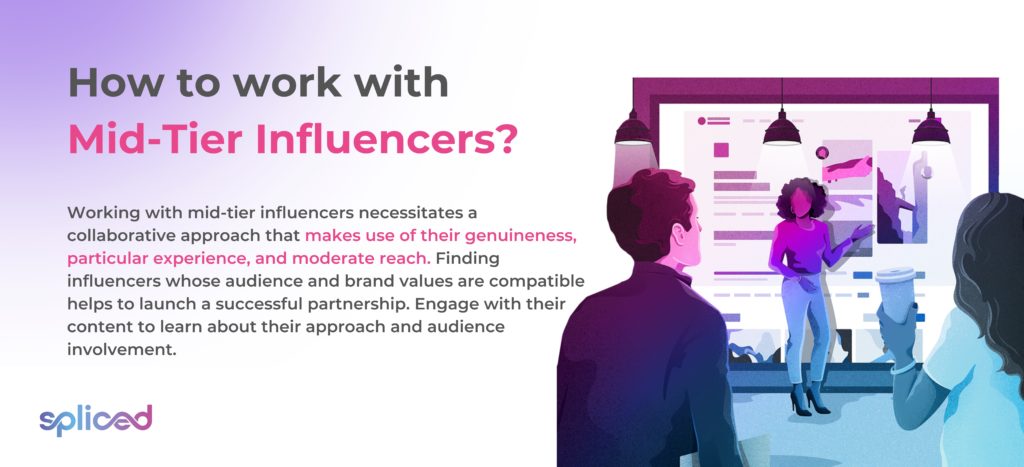
How to work with Mid-Tier Influencers?
Working with mid-tier influencers necessitates a collaborative approach that makes use of their genuineness, particular experience, and moderate reach. Finding influencers whose audience and brand values are compatible helps to launch a successful partnership. Engage with their content to learn about their approach and audience involvement. Send them a personalized message expressing interest in collaborating and detailing the goals of your campaign.
Dealing with Mid-Tier Influencers is often easier than dealing with larger influencers because they are more approachable. They frequently take a hands-on approach and are more receptive to direct communication. Mid-tier Influencers appreciate significant collaborations that complement their content and resonate with their audience. Be open and honest about salary, content needs, and campaign goals while negotiating terms.
A smooth alignment between the company’s message and the influencer’s content style is crucial, though working with mid-tier influencers is more accessible and easier in terms of communication. Maintaining clear communication, setting expectations, and cultivating a real relationship are essential for mutual success in any cooperation.
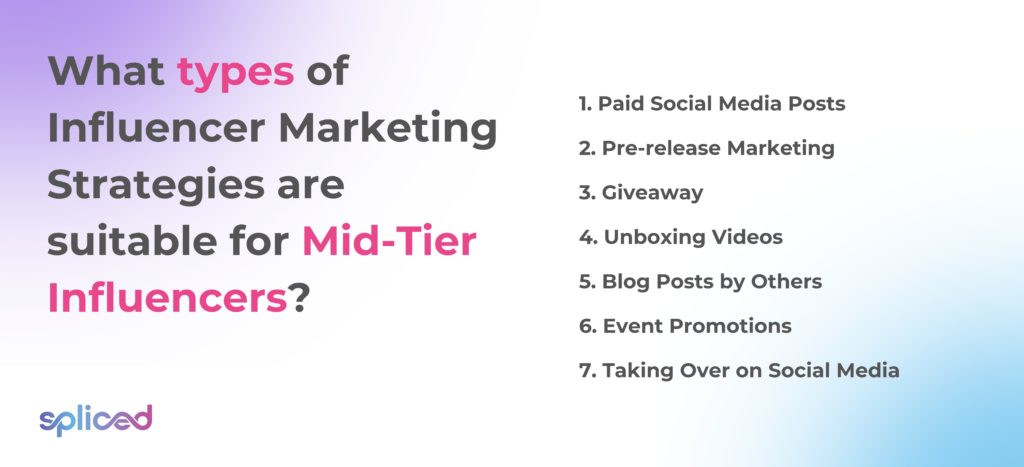
What types of Influencer Marketing Strategies are suitable for Mid-Tier Influencers?
The types of influencer marketing strategies that are suitable for mid-tier influencers are listed below.
- Paid Social Media Posts: The perfect influencer’s social media post has the power to gain trust and increase sales. Aim for influencers who have a high level of interaction, excellent content, and sincerity.
- Pre-release Marketing: Influencer marketing efforts before a product’s official release showcase a product to generate talk and develop anticipation, feeding the “fear of missing out” attitude.
- Giveaway: Giving gifts or prizes is an affordable means of lead generation and promotion. It is another way to encourage viewers to spread the word to their friends, families, or coworkers.
- Unboxing Videos: Influencers take the product out of the box to evaluate the procedure. The form of content assists in refining the narrative of the company for prospective consumers and viewers. Unboxing is more about the experience of getting and utilizing the product than it is about selling it.
- Blog Posts by Others: Guest blog entries are authored by the merchant rather than the publisher. The goal is to establish authority, expand the audience, and increase traffic to the website. Write something that gives value to the lives of the readers.
- Event Promotions: Event activations advertise meetups, events, campaigns, and other related activities. The idea is to collaborate with influencers who boost brand awareness and foster long-term partnerships. The appropriate influencers aid an event to appear legitimate, resulting in increased sales.
- Taking Over on Social Media: Taking control of Social media is an influencer marketing strategy that allows influencers to “take over” a user’s feed for a certain period and allow them to post privileges. It is a type of advertising that introduces the company to new audiences and boosts engagement. Influencers with many supporters are vital for a successful social media takeover.
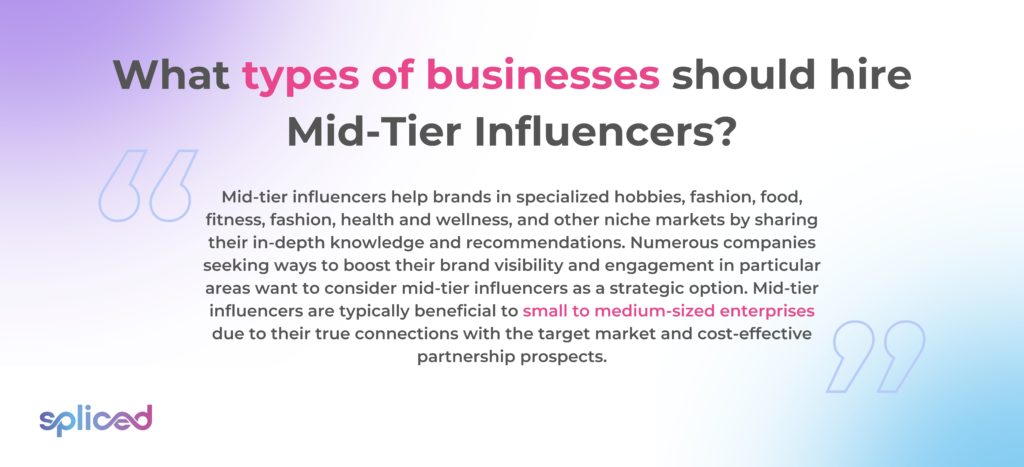
What types of businesses should hire Mid-Tier Influencers?
Mid-tier influencers help brands in specialized hobbies, fashion, food, fitness, fashion, health and wellness, and other niche markets by sharing their in-depth knowledge and recommendations. Numerous companies seeking ways to boost their brand visibility and engagement in particular areas want to consider mid-tier influencers as a strategic option. Mid-tier influencers are typically beneficial to small to medium-sized enterprises due to their true connections with the target market and cost-effective partnership prospects.
E-commerce enterprises wanting to promote specific products or limited-time deals use the engaged communities of mid-tier influencers to achieve focused conversions. Mid-tier influencers are an excellent alternative for brands seeking long-term partnerships and engaging with the target audience. They are ideal partners for brands looking for personal and effective influencer marketing campaigns because of their ability to combine particular expertise with a moderate reach.
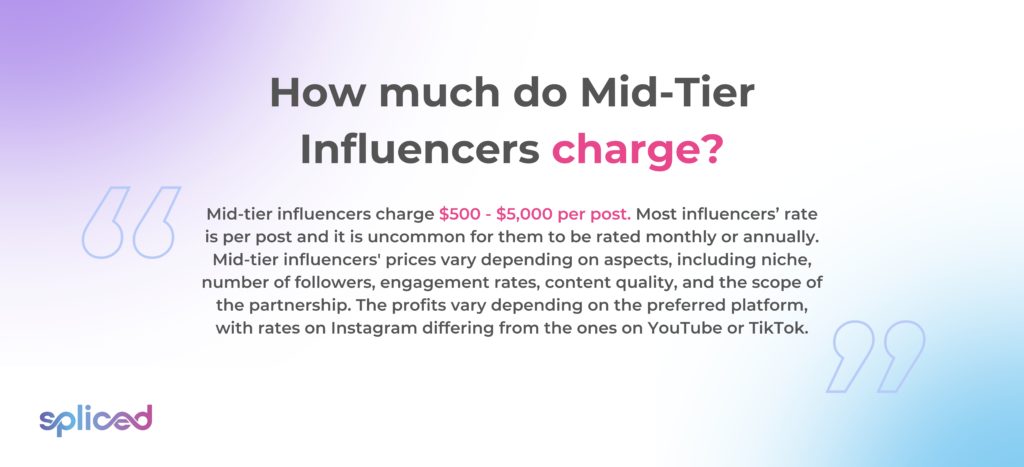
How much do Mid-Tier Influencers charge?
Mid-tier influencers charge $500 – $5,000 per post. Most influencers’ rate is per post and it is uncommon for them to be rated monthly or annually. Mid-tier influencers’ prices vary depending on aspects, including niche, number of followers, engagement rates, content quality, and the scope of the partnership. The profits vary depending on the preferred platform, with rates on Instagram differing from the ones on YouTube or TikTok.
The monthly and yearly incomes of mid-tier influencers range from a few thousand to tens of thousands of dollars, depending on the regularity and variety of their connections. It has to be emphasized that the amounts vary and negotiation helps in creating a mutually advantageous agreement that corresponds with both the influencer’s worth and the budget.
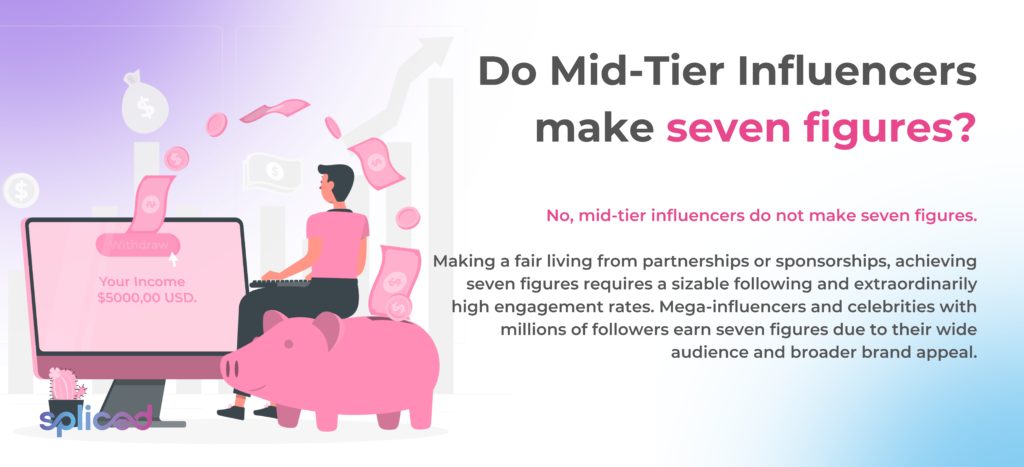
Do Mid-Tier Influencers make seven figures?
No, mid-tier influencers do not make seven figures. Making a fair living from partnerships or sponsorships, achieving seven figures requires a sizable following and extraordinarily high engagement rates. Mega-influencers and celebrities with millions of followers earn seven figures due to their wide audience and broader brand appeal. Mid-tier Influencers have a good living, especially when other revenue streams, such as brand collaborations, affiliate marketing, item sales, and content creation for numerous platforms are considered. It’s necessary to know that influencer earnings vary depending on several factors, and some Mid-Tier Influencers achieve tremendous economic success, but seven-figure earnings are uncommon.
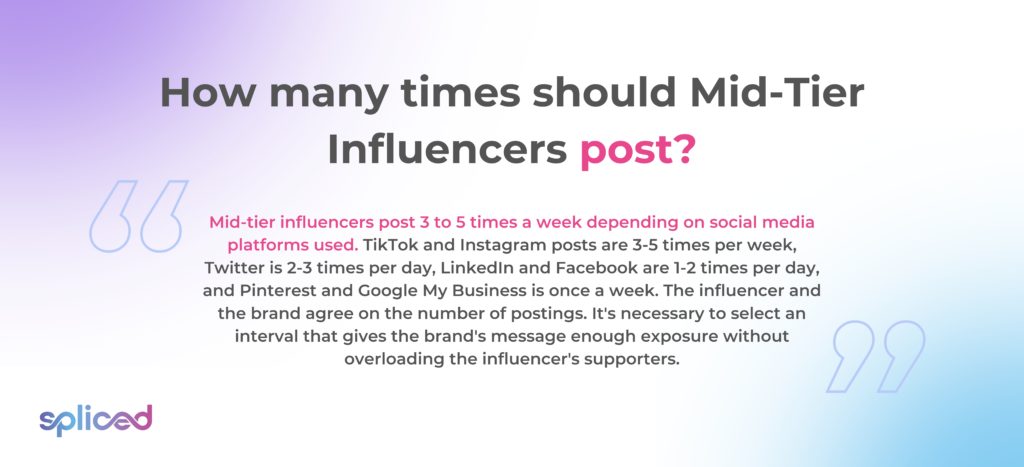
How many times should Mid-Tier Influencers post?
Mid-tier influencers post 3 to 5 times a week depending on social media platforms used. TikTok and Instagram posts are 3-5 times per week, Twitter is 2-3 times per day, LinkedIn and Facebook are 1-2 times per day, and Pinterest and Google My Business is once a week. The influencer and the brand agree on the number of postings. It’s necessary to select an interval that gives the brand’s message enough exposure without overloading the influencer’s supporters. Collaborations include a series of posts stretched out over a set length of time that corresponds to the campaign’s goals and the influencer’s posting schedule.
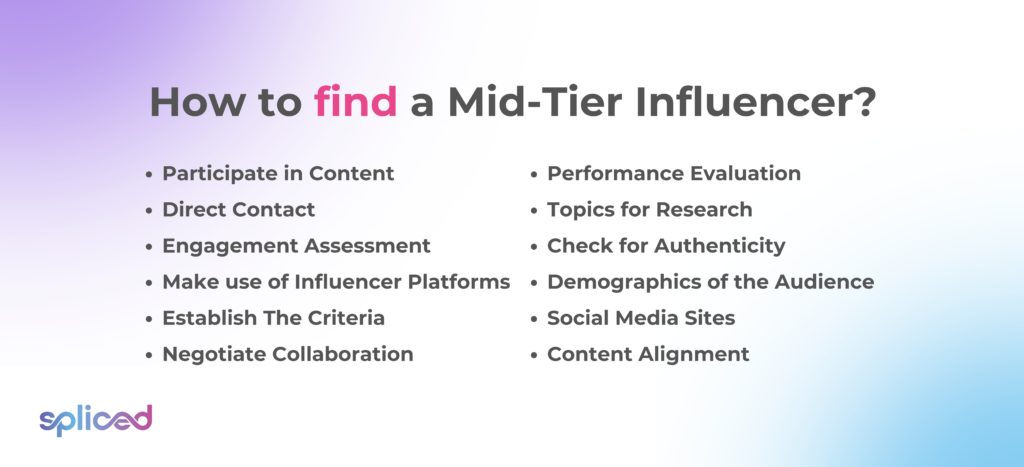
How to find a Mid-Tier Influencer?
To find a mid-tier influencer, follow the steps below.
- Participate in Content: Engage with content posted by potential influencers by liking, commenting, and sharing. It creates a connection and demonstrates genuine interest.
- Direct Contact: Contact potential Mid-Tier Influencers via direct messages or emails. Express the desire for partnership and define the campaign’s goals.
- Engagement Assessment: Search for influencers with a small yet active audience. Examine their interaction levels, likes, comments, and shares to be sure it’s genuine.
- Make use of Influencer Platforms: Make use of influencer marketing networks including Upfluence, AspireIQ, or Traackr. The tools enable to search for and manage influencers based on specified criteria.
- Establish The Criteria: Outline the qualities that are sought in a Mid-Tier Influencer, such as number of followers, specialized relevance, and engagement metrics.
- Negotiate Collaboration: Discuss the conditions of the relationship, pay, content needs, and campaign expectations.
- Performance Evaluation: Follow the success of the cooperation by keeping an eye on website traffic, conversions, engagement metrics, and content performance.
- Topics for Research: Determine the niche or industry that is relevant to the brand or campaign. Investigate hashtags, keywords, and subjects relevant to the specialty on social media networks.
- Check for Authenticity: Check for genuine followers and regular engagement patterns to confirm an influencer’s genuineness.
- Demographics of the Audience: Examine their audience’s demographics to ensure they match the target market.
- Social Media Sites: Search for influencers on internet platforms, such as Instagram, TikTok, YouTube, Twitter, and LinkedIn utilizing important keywords and hashtags.
- Content Alignment: Examine the content of potential influencers to ensure that it is consistent with the values and aesthetics of the company.
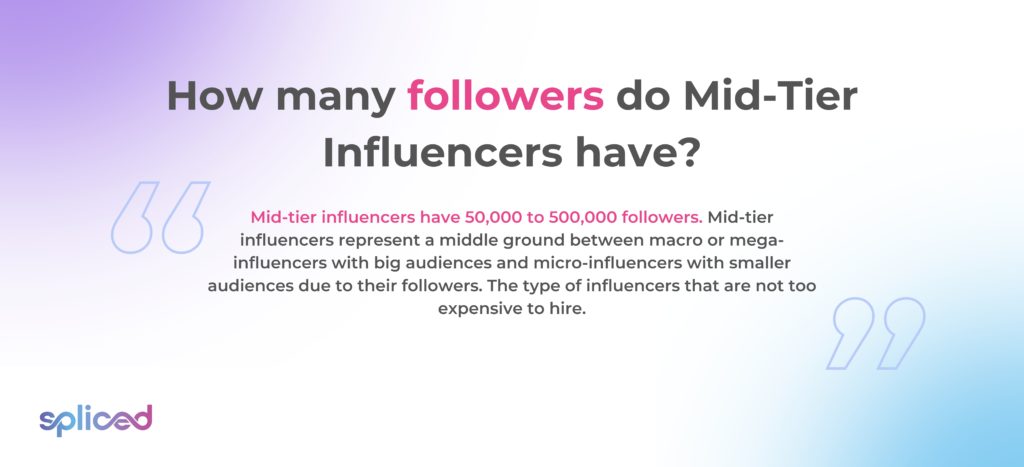
How many followers do Mid-Tier Influencers have?
Mid-tier influencers have 50,000 to 500,000 followers. Mid-tier influencers represent a middle ground between macro or mega-influencers with big audiences and micro-influencers with smaller audiences due to their followers. The type of influencers that are not too expensive to hire. Its small number of followers enables them to find a balance between particular expertise and broader appeal, which allows them to connect with specific target audiences while preserving authenticity and engagement. The audience involvement and connection often add more to the influence than the follower numbers alone.
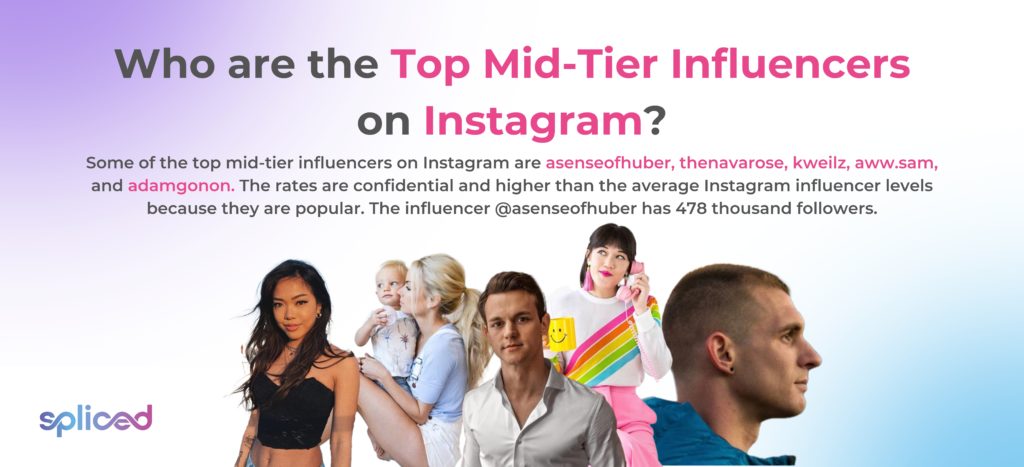
Who are the Top Mid-Tier Influencers on Instagram?
Some of the top mid-tier influencers on Instagram are asenseofhuber, thenavarose, kweilz, aww.sam, and adamgonon. The rates are confidential and higher than the average Instagram influencer levels because they are popular. The influencer @asenseofhuber has 478 thousand followers. Amazing photographer Kyle Huber was born and raised in Missouri and relocated to Los Angeles to pursue a profession in photography. Kyle is well-known for shooting spectacular aerial sights and using cutting-edge cameras and lenses. Kyle has collaborated with popular brands, such as Insta360, Sony, and Carl’s Jr.
Alexa Jade Rose or @thenavarose is a top mid-level Instagram influencer who has 478 thousand followers. Alexa has grown in popularity and is established as one of the top fashion influencers on Instagram. Alexa’s followers appreciate the distinctive DIY and street-style outfits.
Kate Weiland or @kweilz has more than 293 thousand followers and is a superb photographer. Kate has three children and uses Photoshop to create inventive and gravity-defying images to dress them as Christmas trees, hanging from chandeliers, and pretending to be superheroes. She has collaborated with well-known companies, such as VistaPrint, Afterpay, Canon, Lazy One, Carter’s, and others.
Sam Ushiro or @aww.sam has over 290 thousand followers. Sam is an icon of optimistic and colorful house makeover ideas. The influencer became popular for using vivid color schemes, and retro and tasteful ornaments. Sam collaborated with well-known companies, such as LG Electronics, Huffy Bicycles, Find Your Happy Place, Home Goods, Michael’s, and many others.
Adam Gonon or @adamgonon has more than 55 thousand followers and is a men’s fashion Instagram influencer living in New York. Adam is a 28-year-old Instagrammer known for fresh, creative, business-casual outfits, and owns an online men’s apparel store. Being one of the top mid-influencers on Instagram, the man has a taste in fashion that has led to sponsorship opportunities with well-known brands including Maserati, Bacardi, and more.
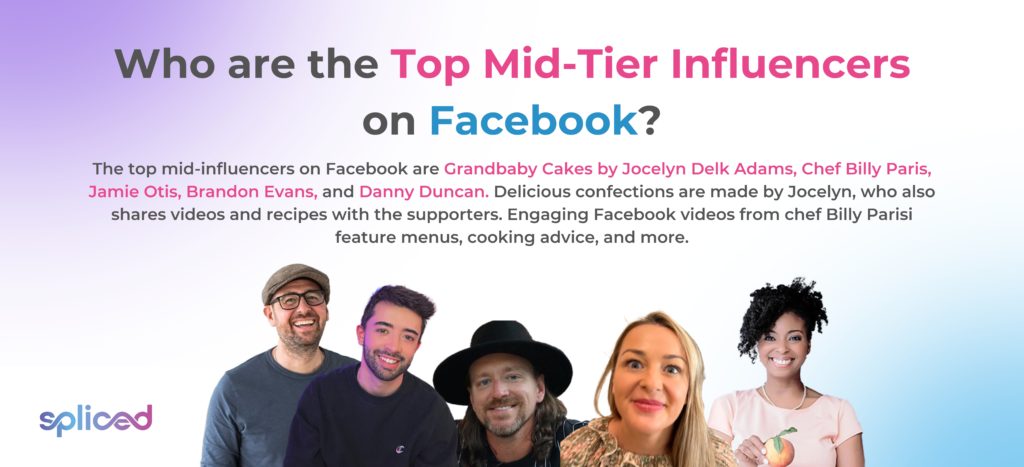
Who are the Top Mid-Tier Influencers on Facebook?
The top mid-influencers on Facebook are Grandbaby Cakes by Jocelyn Delk Adams, Chef Billy Paris, Jamie Otis, Brandon Evans, and Danny Duncan. Delicious confections are made by Jocelyn, who also shares videos and recipes with the supporters. Engaging Facebook videos from chef Billy Parisi feature menus, cooking advice, and more.
An American entertainer and YouTuber named Danny Duncan is well-known for creating crazy and amusing videos that feature pals performing tricks, skateboarding, and other antics. Jamie Otis is an advocate for infertility and women’s health. She first rose to attention as a contestant on “The Bachelor” and had appearances on “Bachelor Pad” and “Bachelor in Paradise.” Danny Duncan is most popular on YouTube and one of the top mid-influencers on Facebook.
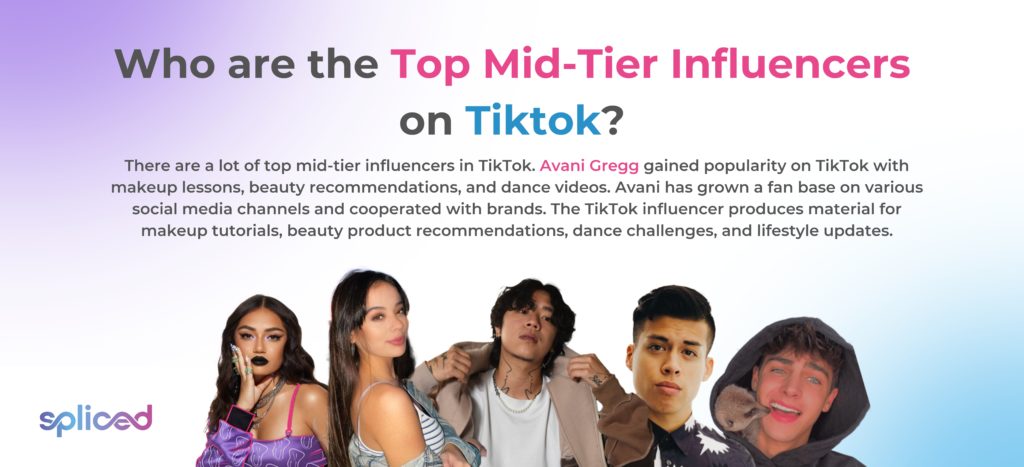
Who are the Top Mid-Tier Influencers in TikTok?
There are a lot of top mid-tier influencers in TikTok. Avani Gregg gained popularity on TikTok with makeup lessons, beauty recommendations, and dance videos. Avani has grown a fan base on various social media channels and cooperated with brands. The TikTok influencer produces material for makeup tutorials, beauty product recommendations, dance challenges, and lifestyle updates. Avani’s prices for brand collaborations vary depending on standards, such as her engagement numbers, the type of campaign, and the field of the client. Rates per post range from a few hundred to a few thousand dollars.
JustMaiko or Michael Le rose to fame on TikTok due to dynamic dance videos and unique materials. Michael frequently works with other influencers and artists. JustMaiko focuses on dancing challenges, inventive choreography, and entertaining music videos. The influencer rates for brand partnerships vary based on the campaign’s goals, the level of involvement, and the industry of the company. Rates per post range from a few hundred to a few thousand dollars.
Lauren Kettering is a dancer and content creator who is well-known for dance videos, lip-syncs, and lifestyle material. Lauren has a sizable TikTok fanbase and videos contain dancing routines, lip-syncs to popular songs, and insights into her daily life. Lauren’s rates for brand collaborations vary depending on factors, such as audience engagement, the scope of the campaign, and the client’s objectives. Rates per post range from a few hundred to a few thousand dollars.
Spencer X gained stardom on TikTok for remarkable beatboxing abilities. Spencer X has worked with several artists and influencers to generate original and entertaining material. The influencer results feature beatboxing skills, collaborations with other creators, and entertaining music videos. Rates per post range from a few hundred to a few thousand dollars, depending on the campaign and company brand.
Kyle Thomas, often known as kylethomas, is popular on TikTok for funny skits, lip-syncs, and relevant daily events. The rates that kylethomas charges for brand collaborations vary depending on criteria, such as engagement metrics, the campaign’s objectives, and the brand’s industry. Rates per post range from a few hundred to a few thousand dollars. Be mindful that the popularity of influencers fluctuates over time as the top mid-tier influencers in the TikTok environment rapidly change.
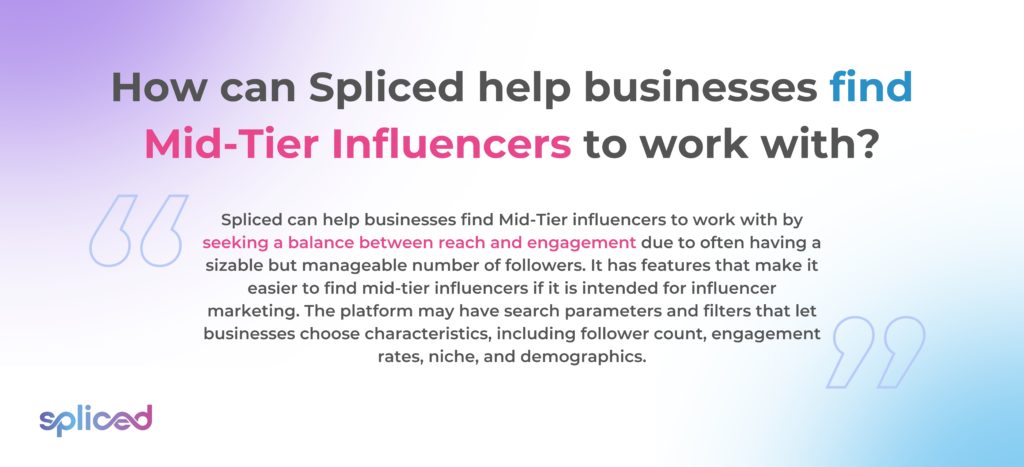
How can Spliced help businesses find Mid-Tier Influencers to work with?
Spliced can help businesses find Mid-Tier influencers to work with by seeking a balance between reach and engagement due to often having a sizable but manageable number of followers. It has features that make it easier to find mid-tier influencers if it is intended for influencer marketing. The platform may have search parameters and filters that let businesses choose characteristics, including follower count, engagement rates, niche, and demographics. The platform provides a well-selected list of mid-tier influencers who support the company’s campaign goals by employing data analytics and algorithms. The benefit of having such a function is that it provides businesses access to a variety of influencers, which makes cooperation more focused and productive. Key features involve an influencer database, audience insights, and communication tools for interacting with influencers.
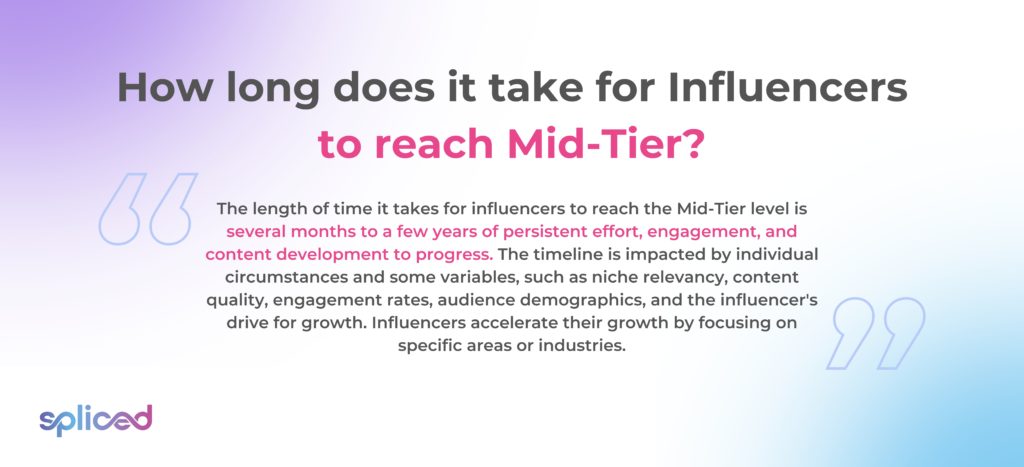
How long does it take for Influencers to reach Mid-Tier?
The length of time it takes for influencers to reach the Mid-Tier level is several months to a few years of persistent effort, engagement, and content development to progress. The timeline is impacted by individual circumstances and some variables, such as niche relevancy, content quality, engagement rates, audience demographics, and the influencer’s drive for growth. Influencers accelerate their growth by focusing on specific areas or industries. Followers are attracted to consistent high-quality material, high engagement rates, collaborations, and related content. Building contacts within the influencer network and concentrating on a distinct voice is beneficial. The secret to effectively growing from a nano influencer to a mid-tier influencer is patience, dedication, and a focus on providing genuine value to the audience. Working with other influencers and taking part in challenges help to accelerate progress.
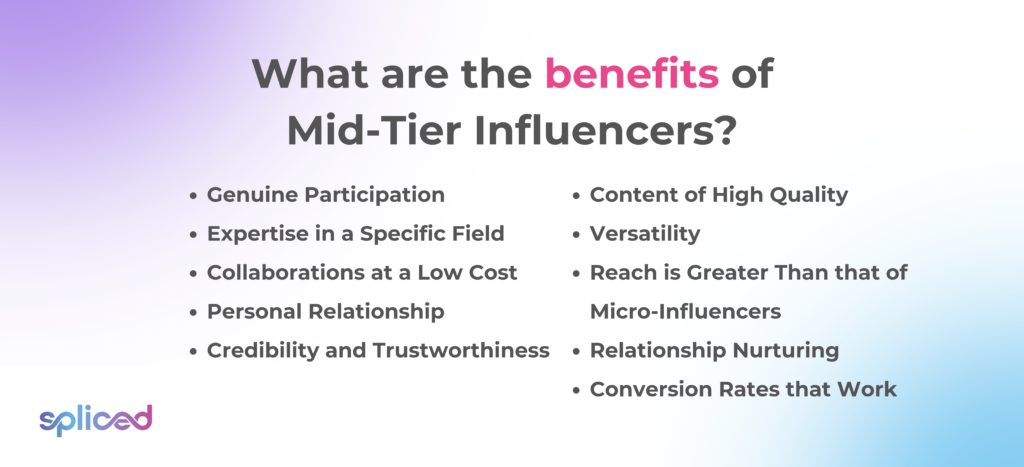
What are the benefits of Mid-Tier Influencers?
The benefits of mid-tier influencers are listed below.
- Genuine Participation: Mid-tier influencers frequently have higher engagement rates than larger influencers. More meaningful relationships and higher levels of trust among their followers result from smaller and more active communities.
- Expertise in a Specific Field: Mid-tier Influencers frequently focus on specialized niches, allowing brands to reach out to specific audiences with similar interests. The in-depth knowledge and competence in a specific field add to the credibility of their endorsements.
- Collaborations at a Low Cost: Working with mid-tier influencers is usually less expensive than working with macro or mega-influencers. Brands gain significant exposure without incurring the higher expenditures associated with larger influencers.
- Personal Relationship: Mid-tier influencers with moderate followers communicate more personally with their audience. It creates a sense of community and deeper ties, increasing their power.
- Credibility and Trustworthiness: The genuineness and active participation instill confidence and credibility in their followers. Mid-tier influencer recommendations often carry more weight due to the perceived authenticity of their material.
- Content of High Quality: Many Mid-Tier Influencers work hard to create high-quality material that resonates with the audience. Brands use the information to supplement their marketing efforts.
- Versatility: Mid-tier Influencers find a balance between specialized knowledge and broader appeal. The adaptability enables them to engage a wide range of audiences while remaining authentic.
- Reach is Greater Than that of Micro-Influencers: Mid-tier influencers offer a more intimate and sympathetic connection than larger influential people but have a wider audience than micro-influencers.
- Relationship Nurturing: Mid-tier Influencers usually invest time in developing meaningful relationships with their audience. The relationship-building turns into more powerful brand endorsements.
- Conversion Rates that Work: The engaged and trustworthy audience is inclined to become consumers. The recommendations lead to higher conversion rates for brands.
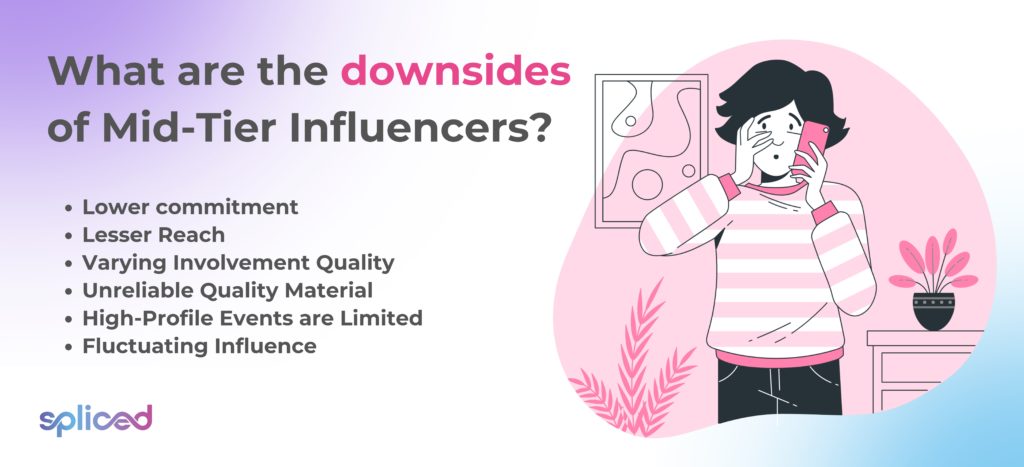
What are the downsides of Mid-Tier Influencers?
The downsides of mid-tier influencers are listed below.
- Lower commitment: The influencers accept practically any campaign that helps them to continue developing on Instagram or YouTube. It is bad for the business because the level of dedication is lesser, which ends up performing a promotion or collaborating with one of the competitors.
- Lesser Reach: Mid-tier influencers with fewer followers have a smaller impact than influencers with larger audiences. Mid-tier influencers are not the best option for an immediate and significant impact.
- Varying Involvement Quality: The level of engagement among Mid-Tier Influencers varies. Many people are highly engaged, but some find it difficult to continue being as genuine and interactive.
- Unreliable Quality Material: Maintaining consistent and high-quality material is not a priority for all Mid-Tier Influencers. Brands must carefully assess an influencer’s material to ensure it meets their requirements.
- High-Profile Events are Limited: Some high-profile events or collaborations favor macro or mega-influencers, which limits opportunities for Mid-Tier Influencers.
- Fluctuating Influence: Influencer popularity is subject to change, and several Mid-Tier Influencers fluctuate in follower growth, engagement rates, or worth over time.
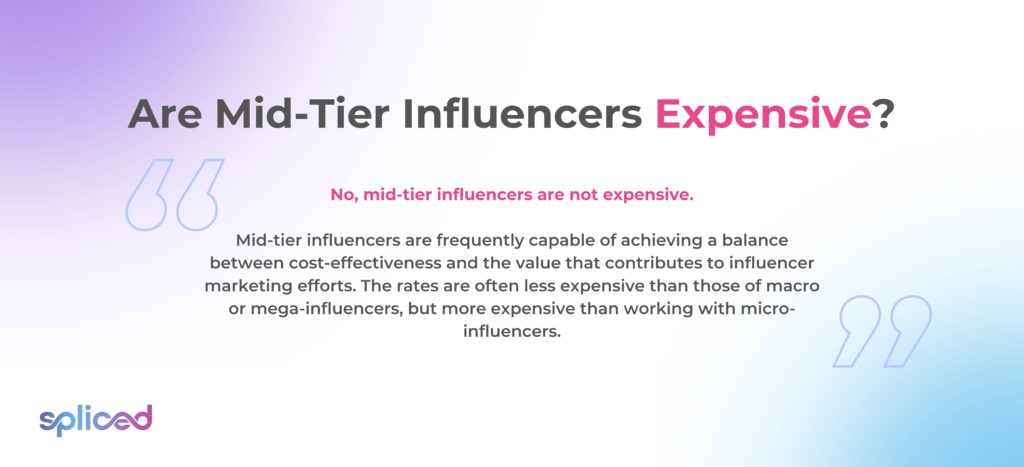
Are Mid-Tier Influencers Expensive?
No, mid-tier influencers are not expensive. Mid-tier influencers are frequently capable of achieving a balance between cost-effectiveness and the value that contributes to influencer marketing efforts. The rates are often less expensive than those of macro or mega-influencers, but more expensive than working with micro-influencers. Working with Mid-Tier Influencers turns out to be expensive depending on a variety of factors, such as their engagement rates, specialized expertise, content quality, and the scope of the campaign.
Firms working with mid-tier influencers anticipate paying anything from a few hundred to a few thousand dollars for each post. Mid-tier influencers are often a cost-effective option for brands looking for effective influencer marketing without paying the high price associated with larger influencers, despite the cost being higher than that of micro-influencers due to the additional benefits.

Are Mid-Tier Influencers worth it?
Yes, mid-tier influencers are worthy. Brands looking for a well-rounded strategy for influencer marketing find that mid-tier influencers are worth the cost. The combination of genuineness and moderate reach creates a one-of-a-kind offering that results in meaningful engagement and excellent campaign results. Mid-tier influencers do not have massive followers of macro or mega-influencers, but the engaged communities frequently result in higher conversion rates and more authentic interactions.
Mid-tier influencers are vital assets for brands that emphasize creating relationships with their supporters, targeting certain niches, and preserving authenticity in their marketing efforts. The goal is to carefully identify influencers whose values coincide with those of the brand, to negotiate fair rates, to develop campaigns that appeal to the influencer’s audience, and to guarantee that the investment in Mid-Tier Influencers converts into real connections and tangible outcomes.
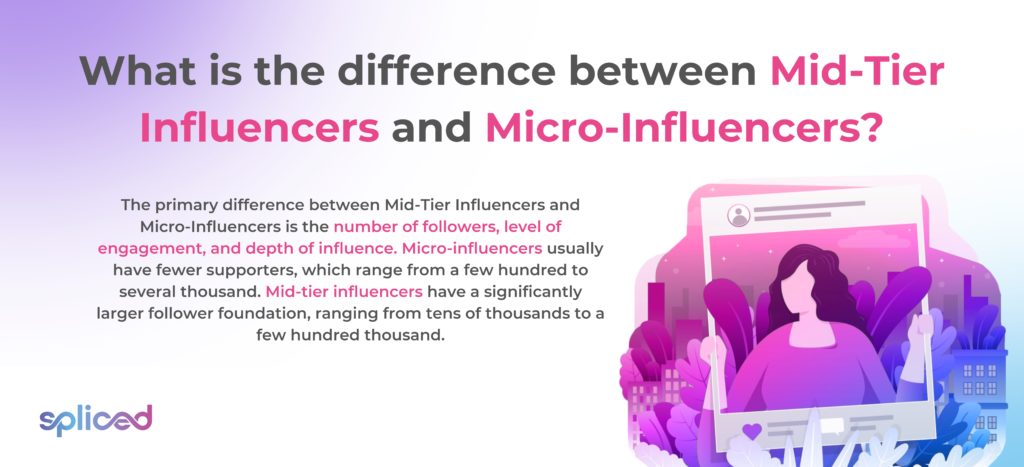
What is the difference between Mid-Tier Influencers and Micro-Influencers?
The primary difference between Mid-Tier Influencers and Micro-Influencers is the number of followers, level of engagement, and depth of influence. Micro-influencers usually have fewer supporters, which range from a few hundred to several thousand. The influence is derived from their highly active and close-knit groups, where the recommendations and endorsements carry tremendous weight due to the personal connections they’ve established. Mid-tier influencers have a significantly larger follower foundation, ranging from tens of thousands to a few hundred thousand. They continue to have high levels of engagement, but reach more people and foster more fruitful relationships because of their wider reach.
Micro-influencers thrive in narrow marketplaces that cater to certain interests or sectors, and they are excellent at driving local or customized campaigns. The transparency and tight ties with the followers foster a true affinity, which leads to increased conversion rates. Mid-tier influencers find a mix between specific expertise and broader appeal. They frequently engage with a broader demographic while maintaining the authenticity that micro-influencers are known for.
Brands looking for highly targeted campaigns within certain niches consider collaborating with Micro-Influencers, while businesses looking for a combination of niche engagement and broader exposure consider working with Mid-Tier Influencers. The decision between the two depends on the goals of the brand and the desired level of audience engagement for influencer marketing. Every form has specific advantages for micro-influencers.
